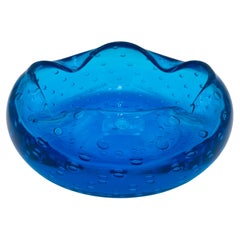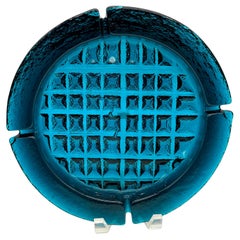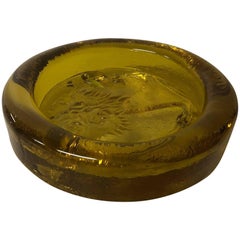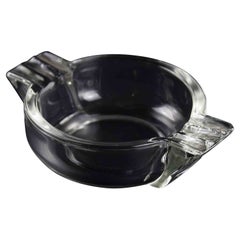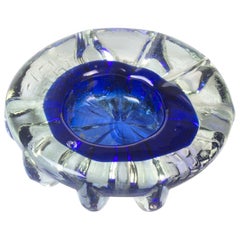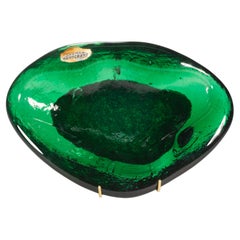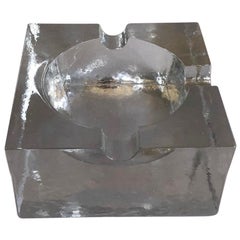Blenko Ashtrays
A producer of hand-blown glass since 1893, Blenko Glass is currently headquartered in Milton, West Virginia, where it has operated since 1921. Among its many illustrious projects are the stained-glass windows it produced for St. Patrick’s Cathedral and the Washington National Cathedral. Blenko is known today for the brilliant colors of its glass vases, decanters and other vessels and objects — particularly those produced in the 1950s and ’60s — which range from jewel-like blues and greens to brilliant reds and yellows.
The company was founded by William J. Blenko, an English immigrant who was apprenticed to a glassmaker in his native London as a young man. Blenko developed expertise in the production of rondels, the round panes used in stained glass windows.
Blenko's interest in the potential of natural gas to fire glass furnaces led him to Milton, where abundant reserves of the fuel had attracted a pool of skilled glassblowers. Under the name Eureka Glass, his company began making window glass in 1923, and in 1925, he was joined in the business by his son, William H. Blenko.
When the Great Depression quelled demand for stained glass, William J. Blenko brought local Milton glassblowers into the company to begin producing stemware and tableware, products for which the company, which changed its name to Blenko in 1930, is now best known.
Up until the end of World War II, Blenko’s tableware designs were fairly straightforward, and they sold well at American department stores such as Gump’s, in San Francisco. The company was also commissioned in 1930 to produce a line of reproductions for Colonial Williamsburg.
In 1947, the company hired as its art director Winslow Anderson, who introduced artful, fanciful and modern vessels and objects in vibrant colors. This began what collectors refer to as Blenko’s “historic period.” A number of Anderson’s designs were honored by the Museum of Modern Art’s Good Design Awards in 1950, and throughout the 1950s and ‘60s, the company enjoyed robust sales and critical acclaim. The forms Blenko produced during this period followed the contemporary vogue for biomorphism, or organic modernism, which favored rounded and fluid shapes inspired by nature.
One of Blenko’s most influential designers, Wayne Husted, who was active from 1953 to ’63, is credited with aligning Blenko’s products with the prevailing mid-century modern aesthetic by pushing the envelope on both form and color, particularly in his wedge-cut and Spool decanters and his Echoes series.
Joel Philip Myers, who designed for Blenko in the 1960s, brought a sense of whimsy and visual excess to the product line, in keeping with the psychedelic look favored during the period.
Blenko Glass still produces many of its classic designs in items ranging from stemware and tableware to decorative objects and ornamental decanters.
Among collectors, pieces created under Husted’s creative direction are of special interest. The company has come to the attention of younger audiences through the documentaries Blenko: Hearts of Glass and Blenko Retro: Three Designers of American Glass, both of which aired on PBS. Blenko also designed the glass award trophy for the Country Music Awards.
Find vintage Blenko glass for sale on 1stDibs.
1960s Mid-Century Modern Vintage Blenko Ashtrays
Art Glass
20th Century American Mid-Century Modern Blenko Ashtrays
Glass
Mid-20th Century American Mid-Century Modern Blenko Ashtrays
Glass
1970s Italian Vintage Blenko Ashtrays
Glass
1970s Italian Vintage Blenko Ashtrays
Glass
1970s Italian Mid-Century Modern Vintage Blenko Ashtrays
Art Glass
Mid-20th Century Italian Mid-Century Modern Blenko Ashtrays
Glass, Art Glass, Murano Glass
Mid-20th Century Czech Mid-Century Modern Blenko Ashtrays
Glass, Art Glass
1970s Italian Hollywood Regency Vintage Blenko Ashtrays
Crystal
1970s European Vintage Blenko Ashtrays
Art Glass
1970s French Modern Vintage Blenko Ashtrays
Bronze
Mid-20th Century Italian Blenko Ashtrays
Crystal
1970s Mid-Century Modern Vintage Blenko Ashtrays
Bronze
1960s Italian Mid-Century Modern Vintage Blenko Ashtrays
Murano Glass
Mid-20th Century Italian Modern Blenko Ashtrays
Murano Glass
Mid-20th Century American Mid-Century Modern Blenko Ashtrays
Glass
Mid-20th Century American Mid-Century Modern Blenko Ashtrays
Glass
Blenko ashtrays for sale on 1stDibs.
Creators Similar to Blenko
- How can you tell vintage Blenko?1 Answer1stDibs ExpertOctober 24, 2024To tell vintage Blenko, conduct research using trusted online resources to try and date your piece. To be considered vintage, Blenko glassware must be between 20 and 99 years old. Pieces that are at least 100 years old are antiques. Because many Blenko pieces are unmarked, the best way to identify them is by examining their physical characteristics, such as color, shape and style. Looking through the maker's catalogues — available to browse online — can give you an idea of your glassware's approximate production year. Alternatively, you can have a certified appraiser or knowledgeable antique dealer perform the dating process. Find a collection of Blenko glass on 1stDibs.
- 1stDibs ExpertAugust 29, 2024To know if Blenko is real, first check it for markings. Over the years, Blenko has used foil stickers and sandblasted markings to identify its pieces. Comparing the markings on your piece to pictures shared on trusted online resources is a good way to begin the authentication process. If you notice major discrepancies, your piece may be a reproduction. Next, search Blenko catalogs to find out if Blenko ever produced a piece like yours. From there, you can learn about the characteristics of the specific item and use them as the basis for evaluation. Alternatively, you can consult a certified appraiser or knowledgeable antique dealer for their expert opinion. On 1stDibs, shop an assortment of Blenko glass.
- What type of glass is Blenko?1 Answer1stDibs ExpertApril 5, 2022Blenko glass is hand-blown sheet glass that is used for stained glass windows or architectural glass. The Blenko Glass Company is most recognized for their work with the St. Patrick's Cathedral in New York City. Shop a wide selection of Blenko glass goods on 1stDibs.
- How do I identify a Blenko lamp?1 Answer1stDibs ExpertApril 5, 2022Identifying a Blenko lamp often comes down to studying the forms and shapes of authentic Blenko lamps and comparing similar pieces. Since the majority of Blenko glass lamps will no longer have the sticker that was used for identification, you can look at books that are basically reprints of the annual Blenko catalogue, visit a collector-run website, or have a professional assessor look at it. On 1stDibs, find a selection of Blenko lamps from top sellers worldwide.
- 1stDibs ExpertMay 14, 2024To identify Blenko glass, look for markings, usually found on the bottom. Over the years, the American glassmaker has used dozens of different markings, so the best approach is to compare yours to images shared on trusted websites for reference purposes. Once you've confirmed that your piece is a Blenko, you can download Blenko glass catalogues from online sources and search for your piece to learn more about it. Alternatively, you can have an appraiser or dealer who specializes in glassware evaluate your piece. Find a wide range of Blenko glass on 1stDibs.
- 1stDibs ExpertAugust 15, 2024To tell if your glass is Blenko, look for the maker's mark, which usually appears on a label affixed to an inconspicuous area of the piece, such as the interior or bottom. The American glassmaker marked most of its pieces, but some weren't marked, and others may have lost their labels over the years. If you can't find a label, compare your piece to images found in Blenko glass catalogues available through trusted online resources. A certified appraiser or knowledgeable antique dealer can also be of assistance. Find a wide variety of Blenko glass on 1stDibs.
- 1stDibs ExpertApril 5, 2024A few things account for what is so special about Blenko glass. The vibrant colors that the brand is famous for set it apart, as do its imaginative designs. In addition, Blenko is known for its quality crafting techniques and for its rich history, which dates back to 1921. Explore a selection of Blenko glass on 1stDibs.
- 1stDibs ExpertNovember 4, 2024To identify your Blenko pitcher, use the company's catalogues. From the official Blenko website, you can download every catalogue the company has produced since the 1950s, and there are additional trustworthy websites that have catalogues and reference galleries for older pieces. Browsing through these references can allow you to find your pitcher and learn about its style, name, age and other characteristics. Alternatively, you can enlist the help of a certified appraiser or experienced antique dealer. Shop a range of Blenko pitchers and other Blenko objects on 1stDibs.
- 1stDibs ExpertApril 5, 2022West Virginia-based Blenko Glass Company made its beloved jewel-toned, hand-blown glass lamps from 1947 through 1963. The company, established in 1893, has operated out of Milton, WV, since 1921, and started out producing glass vases and decanters. On 1stDibs, find a selection of Blenko pieces from top sellers worldwide.
- Is Blenko glass still made?1 Answer1stDibs ExpertMarch 22, 2022Yes, Blenko glass is still made. The Blenko Glass Company produces their products at a company-owned factory in Milton, West Virginia. It opened in 1921 and is well known for producing decorative bottles, bowls and vases. Find a selection of Blenko glass on 1stDibs.
- 1stDibs ExpertApril 5, 2022To know if glassware is Blenko glass, you will likely need to seek the help of a licensed appraiser. Blenko did not sign most pieces and did not create specific patterns. As a result, it is usually not possible to identify Blenko glass using only online resources. On 1stDibs, shop a variety of expertly vetted Blenko glassware.
- 1stDibs ExpertApril 22, 2024Rose is the color of Blenko glass that tends to be the most valuable, followed by other intense jewel tones. Generally, the honey and pale green colors are less frequently sought after by collectors. However, there are exceptions. Keep in mind that the age, condition and type of glassware will also impact its value. Explore a range of Blenko glass on 1stDibs.
